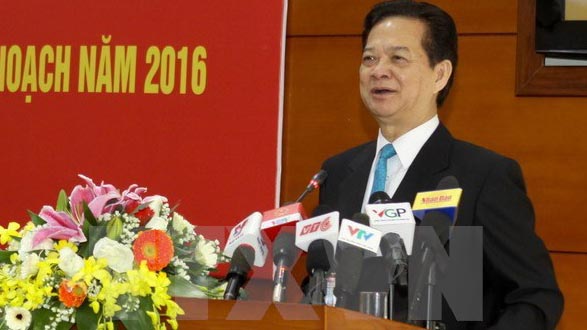Science-technology crucial to agriculture restructuring
Wednesday, 09:17, 06/01/2016
Promoting the application of science and technology is the decisive factor to agriculture restructuring, Prime Minister Nguyen Tan Dung told the agriculture sector at a conference in Hanoi on January 5.
He urged the sector to build specific mechanisms and policies to facilitate the application of science and technology to increase productivity, create high-quality and competitive products, and improve farmers’ incomes.
The PM also suggested multiplying integrated production models towards large-scale production with high efficiency to enhance competitiveness in the context of integration.
Special attention should be paid to restructuring State-run farm and forestry enterprises as well as developing infrastructure in rural areas and encouraging businesses to invest in the countryside, he said.
At the same time, the Government leader required continued efforts to implement the national target programme on building new-style rural areas, with the focus on renovation production models in rural areas to increase farmers’ income and mobilising social resources for investment in rural areas.
Coping with natural disasters is another important task for the agricultural sector, he said, instructing the sector to map out plans on preventing and mitigating impacts of natural disasters, particularly when Vietnam is forecast to be one of the nations most vulnerable to consequences of climate change.
It was reported at the conference that between 2011 and 2015, the agriculture sector posted an annual GDP growth of 3.13%, surpassing the target of the 11 th Party Congress’s Resolution of 2.6%-3%.
By the end of 2015, the country had 1,478 new-style rural communes (16.5% of total communes nationwide), up 693 communes against the previous year, while 15 districts won recognition as new-style rural areas.
Minister of Agriculture and Rural Development Cao Duc Phat said the agro-forestry-seafood sector aims for a GDP growth of 3% in 2016 and 2.5%-3% between 2016 and 2020.
The sector will also strive to reduce the number of poor households in rural areas by an average 2% annually between 2016 and 2020.
As many as 23%-25% of communes are hoped to fulfill 19 criteria of new-style rural areas by the end of 2016 and the figure will be raised to 50% by 2020.
The PM also suggested multiplying integrated production models towards large-scale production with high efficiency to enhance competitiveness in the context of integration.
Special attention should be paid to restructuring State-run farm and forestry enterprises as well as developing infrastructure in rural areas and encouraging businesses to invest in the countryside, he said.
At the same time, the Government leader required continued efforts to implement the national target programme on building new-style rural areas, with the focus on renovation production models in rural areas to increase farmers’ income and mobilising social resources for investment in rural areas.
 |
| Prime Minister Nguyen Tan Dung speaks at the event (Photo: VNA) |
Coping with natural disasters is another important task for the agricultural sector, he said, instructing the sector to map out plans on preventing and mitigating impacts of natural disasters, particularly when Vietnam is forecast to be one of the nations most vulnerable to consequences of climate change.
It was reported at the conference that between 2011 and 2015, the agriculture sector posted an annual GDP growth of 3.13%, surpassing the target of the 11 th Party Congress’s Resolution of 2.6%-3%.
By the end of 2015, the country had 1,478 new-style rural communes (16.5% of total communes nationwide), up 693 communes against the previous year, while 15 districts won recognition as new-style rural areas.
Minister of Agriculture and Rural Development Cao Duc Phat said the agro-forestry-seafood sector aims for a GDP growth of 3% in 2016 and 2.5%-3% between 2016 and 2020.
The sector will also strive to reduce the number of poor households in rural areas by an average 2% annually between 2016 and 2020.
As many as 23%-25% of communes are hoped to fulfill 19 criteria of new-style rural areas by the end of 2016 and the figure will be raised to 50% by 2020.
